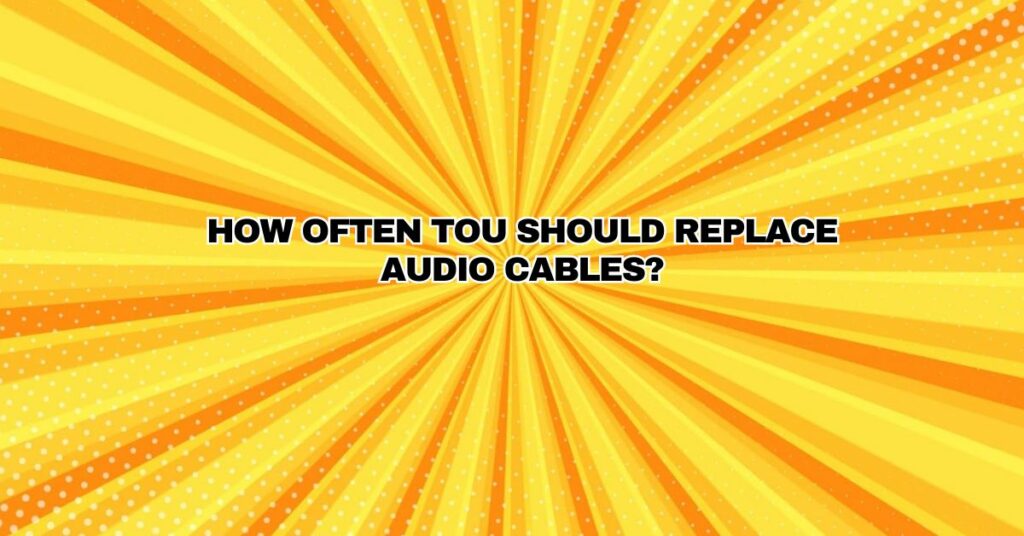Audio cables are a fundamental component of any sound system, connecting audio sources to amplifiers and speakers. Over time, these cables can experience wear and tear, potentially affecting audio quality. The question of how often you should replace audio cables is a common one among audio enthusiasts. In this comprehensive article, we’ll explore the factors that influence the lifespan of audio cables, signs that indicate replacement is needed, and how to extend the longevity of your cables.
1. Quality of Cables:
The quality of the audio cables you purchase is a significant determinant of their lifespan. High-quality cables made from durable materials are likely to last longer than inexpensive or lower-quality alternatives. When investing in audio cables, consider the materials used, the design, and the reputation of the manufacturer.
2. Frequency of Use:
The more frequently you use your audio cables, the more wear and tear they’ll experience. Cables in high-use environments, such as professional audio setups or recording studios, may need replacement more often than those in less frequently used systems.
3. Cable Type and Thickness:
The type and thickness of audio cables can influence their durability. Thicker cables, such as 12 AWG speaker wire, are generally more robust and can withstand more wear and tear. The choice of cable type and thickness should align with your specific needs and system requirements.
4. Environmental Factors:
The environment in which audio cables are used can have a significant impact on their lifespan. Consider the following environmental factors:
- Temperature and Humidity: Extreme temperatures and high humidity can accelerate cable deterioration. Store and use your cables in a climate-controlled environment whenever possible.
- Exposure to Sunlight: Direct exposure to sunlight can lead to insulation degradation. Keep cables out of direct sunlight.
- Chemical Exposure: Avoid placing cables near chemicals or solvents that can damage insulation or connectors.
- Moisture and Water: Audio cables are not typically waterproof. Exposure to moisture or water can lead to corrosion, affecting cable performance and lifespan.
5. Quality of Connectors:
Connectors on audio cables can wear out over time, potentially affecting the cable’s performance. High-quality connectors are less prone to wear and offer longer-lasting connections. Regularly inspect connectors for signs of wear and replace them as necessary.
6. Technological Advances:
As technology advances, you might consider upgrading your audio cables to take advantage of improved materials and design. Upgrading can enhance audio quality and potentially extend the lifespan of your system.
7. Routine Maintenance and Inspection:
Regularly inspect your audio cables for signs of wear, damage, or degradation. Signs that your cables may need replacement include:
- Visible Wear: If you notice fraying or exposed wires on the cable, it’s a clear sign that replacement is necessary.
- Audio Distortion: If you experience audio distortion, intermittent connectivity, or signal dropouts, your cables may be the culprit.
- Loose or Damaged Connectors: Loose or damaged connectors can result in poor connections and audio quality issues.
- Corrosion: If connectors show signs of corrosion or oxidation, they may need replacement.
- Cable Tension: Cables subjected to excessive tension, tugging, or bending at sharp angles may become damaged and require replacement.
8. Upgrades and System Changes:
When making upgrades or significant changes to your audio system, consider whether your existing cables are still suitable for the new setup. In some cases, you may need different types or lengths of cables.
Conclusion: Maximizing the Lifespan of Audio Cables
The frequency at which you should replace audio cables depends on various factors, including cable quality, usage, environmental conditions, and regular maintenance. To maximize the lifespan of your audio cables:
- Invest in high-quality cables made from durable materials.
- Regularly inspect and maintain your cables.
- Store and use your cables in a suitable environment.
- Consider upgrading when technology advances or your system changes.
- Replace cables if you experience visible wear, audio distortion, or connector issues.
Ultimately, the lifespan of your audio cables is influenced by how well they are treated and the conditions in which they are used. By following these guidelines, you can enjoy reliable audio connections and high-quality sound for years to come.


